Famous Foods You Must Eat in Barcelona
Famous foods you must eat in Barcelona are readily available as part of daily cuisine in the Catalan capital. Whenever we have a trip to Spain planned we get excited for the sites…and the FOOD!
Delicious things to eat in Barcelona, like top-quality ham and olives, are part of the everyday lives of Spanish people. And you have to try it all to really experience the culture in addition to seeing the city's famous sites.
Let's face it: their food is a famous attraction in itself! The Barcelona food scene is strong.
Disclosure: This post has affiliate links, meaning we may earn a small commission if you click the link and proceed with a purchase at no cost to you. Though we were hosted by Devour Tours, we recommend experiences, hotels, products, and services we use and support. As Amazon Associates, we earn from qualifying purchases.
Top Things to Eat in Barcelona
We go into detail in the items below, but here is an overview of famous food to try in Barcelona, which is home to Catalan cuisine, the region where the city is.
You'll definitely want to drown yourself in Jamón Ibérico (Iberian ham), a favorite of both of ours. The nutty ham is incredible, and you'll dream about it for long after you've left Barcelona. Jamón Serrano is a close second contender to its Ibérico version.
Olive products of all kinds are dreamy in Spain, including in Barcelona. Whether olive oil or green or black olives, it's a Spanish staple.
Spanish tapas are legendary. We've had little portions of paella that we enjoy at bars, as well as pinchos that also pair well with beers!
But that's only some of the things you must try in Barcelona. Read on for more info and additional places to find it all.
Where to Taste All this Delicious Food You Must Eat in Barcelona
These things you must eat in Barcelona are available all over the city. Nothing on the items on this list of things to eat in Barcelona is hard to find.
You may have to go to a seafood restaurant or market to find things, like prawns or olives, of course. But that's typical of any location. Certain eateries have one specialty while another restaurant may offer something different.
However, there is a way to try all the food items in one fell swoop, and that's with a food tour. We take food tours in any new country or city we go to. (We love to eat and learn about a new culture through food!)
Barcelona Food Tour
If you want to get even more information and history about these well-known foods in Barcelona, we can't recommend a Devour Food Tour enough. (We have grown to LOVE Devour Food Tours all over Europe.)
They're the best for several reasons, including their wonderful guides, small group tours, and where they take you. But because they also send us awesome information about the city we're going to before and after our tour. They develop a relationship with their customers and for foodies like us, that's been a positive relationship we can't get enough of.
Barcelona Food Markets and Food Halls
Two of the most famous food markets and halls are La Boqueria and El Nacional. They have two totally different vibes, histories, and purposes.
1. La Boqueria, Food Market
The market's history can be traced back to its roots in the 13th century. Yet the market we know today was designed and flourished even further in the 19th century.
This is definitely the most touristy market in Barcelona. The avenue it's on, La Rambla, is Barcelona's most famous, open to pedestrians only.
Be sure to go deeper inside the market to not be priced gauged! The vendors closer to the entrance charge more for their food and products. The deeper in you go the better the prices are because they know fewer tourists venture past the first line of vendors.
It leads from the center of the city down to the water. The market's official name, whose beautiful Gaudi-inspired archway above its entrance proclaims its presence, is Mercat de St. Josep de la Boqueria. (Gaudi is renowned for architecture in Barcelona. He most famously designed La Sagrada Familia church.)
Somehow the market doesn't feel quite as welcoming to tourists as San Miguel Market in Madrid did, for instance. This may be because you can buy things like ingredients for recipes (like whole fresh fish), which most tourists aren't doing unless they stay in an Airbnb with a kitchen.
But this market doesn't have as many grab-and-go things as other markets we've been to, like in Madrid. (Even though they do have some grab ‘n go items.)
A favorite item to get there is fresh squeezed or blended juice for €1. (It is €2 if you get it just inside the market, but half the price the deeper you walk inside.)
2. El Nacional, Food Hall
This food hall really blew us away. It's gorgeous, as a newer food hall in Barcelona.
The building used to be an old…get ready for it…parking deck! Yes, a parking deck! Be sure to check out the progress photos from the parking deck times to know in the restroom. Yup, the restroom.
It's a gorgeous place to go, and they're open late in true Catalan style.
After full days of touring and site-seeing in Barcelona, Dan and I enjoyed popping in here for wine and cheese on more than one occasion to close out our evenings. (Our centrally located hotel, the Renaissance Barcelona Hotel on Pau Claris, was just blocks away.)
They are open every day from noon to midnight. Easy peasy.
Their location is yet another famous avenue in Barcelona: Passeig de Gràcia, near where 83.3 Barcelona rooftop bar is located.
We also consider El Nacional to be one of the best food market halls around the world. It has various little restaurants and eateries inside as well as a wine bar and cava bar.

Onto more meat of the post with what to eat in Barcelona, no pun intended…
Fideua
Fideua is very similar to Paella, but its a Catalan version of the dish. It's made with noodles instead of rice. Our Barcelona Devour Food Tour guide, Alvaro, shared the best place to get Fideua in Barcelona is in the neighborhood Barceloneta, right by the water.
He was kind enough to recommend Can Ramonet. We loved it there. It had a slightly nautical theme (which made sense – it's by the water and they have lots of seafood on their menu) and the neighborhood it's in, historically working class, had plenty of character.
We enjoyed the seafood fideua below with little clams and pieces of squid. It was a huge serving. The “paella” pan it's made in is shallow (which is literally the name of the pan, which is how paella got its name, which we learned in Valencia). But it's still a fair amount of food.
➜ Space is limited: Book your Barcelona food tour now


Paella
Though this traditional Spanish dish is easy to find in Barcelona, mostly because of tourists desiring it, it's not one of the Catalan dishes that is traditional. It is, nonetheless, a tasty rice dish native to nearby Valencia.
But if you can't get to Valencia to try the truly local paella, which you can still find cooked in the traditional manor over an open flame at some restaurants, find a great restaurant to try it in Barcelona. They're usually offered at touristy spots, even though we hate to say that.
Try the rabbit or chicken versions, or seafood paella.
You can also take a cooking class in Barcelona, which will more than likely teach you how to make paella.
Tapas
This refers to a specific style of food in Spain, where small portions of a dish are served on a plate. Typically, you order a few plates to make a meal. You can find great tapas bars and restaurants in Barcelona just like you can in Seville or Madrid.
Personally, it's a favorite way to dine since you don't need a main dish; you simply make a meal out of small plates and get to try a little of a lot! (Or as much as you order.)
We continuously recommend Ciudad Condal to family and friends traveling to Barcelona, and it's always a hit. We love (and prefer) to sit at the bar there to see what other people are ordering, what freshly comes out of the kitchen, and be more of a part of the hustle and bustle of this popular Barcelona restaurant.
There's a reason it has 4.5 stars out of 5 on over 10,300 ratings on TripAdvisor!
La Cova Fumada is another popular tapas restaurant in Barcelona. They underwent renovations in late 2022 and reopened in 2023. They have over 1,400 4.5 reviews on TripAdvisor.

Pinchos
Oh my gosh – if I could eat one thing in Barcelona for a day, this would be it. Why? There are SO many varieties, and I love a little variety in my meal! Ideally, I want a little bit of everything.
Pinchos, or pintxos, are pretty much a slice of baguette-type bread topped with anything. We had ones topped with eggs, peppers, Spanish croquettes, bacon, tomatoes, fish, burgers…you name it. They topped it.
And guess what? They're only €1 to about €4 EACH. Can you believe it?
We went to more than one restaurant, but our favorite in Barcelona's “pincho alley” was at La Tasqueta De Blai.
TIP: go in between hours to get a seat. They don't have a lot of seating and it got really busy. We arrived around 4:00pm, sat at the bar (in front of the pinchos) and witnessed more and more people coming in as the hours went buy. It can get busy.
Getting there early also helped us develop a rapport with the bartenders who were the ones serving drinks but also let us know what was on each pincho.


Ham
If you are a carnivore and you visit Barcelona but didn't have “jamón”, or ham, were you even there?
One of the most delectable things you can eat in Barcelona is ham. They have two main types: Serrano and Iberican.
The latter is the pricier of the two and tastes a bit nuttier. This is because the free-range Iberian pigs eat only a diet of acorns in their last weeks of life. It gives their meat a very rich flavor.
We had a wonderful lesson in how jamón plays into the culture of the Spanish people during our Devour Tour with Alvaro. For instance, a leg of ham is a special gift to give family during the holidays. (But to learn more you'll have to take the tour!)
We even tasted various hams at a specialty store on our Barcelona food tour. It was really interesting to taste the hams in a particular, logical order that our guide, Alvaro, laid out for us. He explained each piece of ham as we tasted them.
The two pieces we're holding in the photo below are by far the best we've ever tasted. It costs €230 per kilo! But it was all included in the price of our tour. What a treat!
Alvaro also taught us why the back legs cost more money than the front and that a black hoof indicates the pig is 100% Iberian.
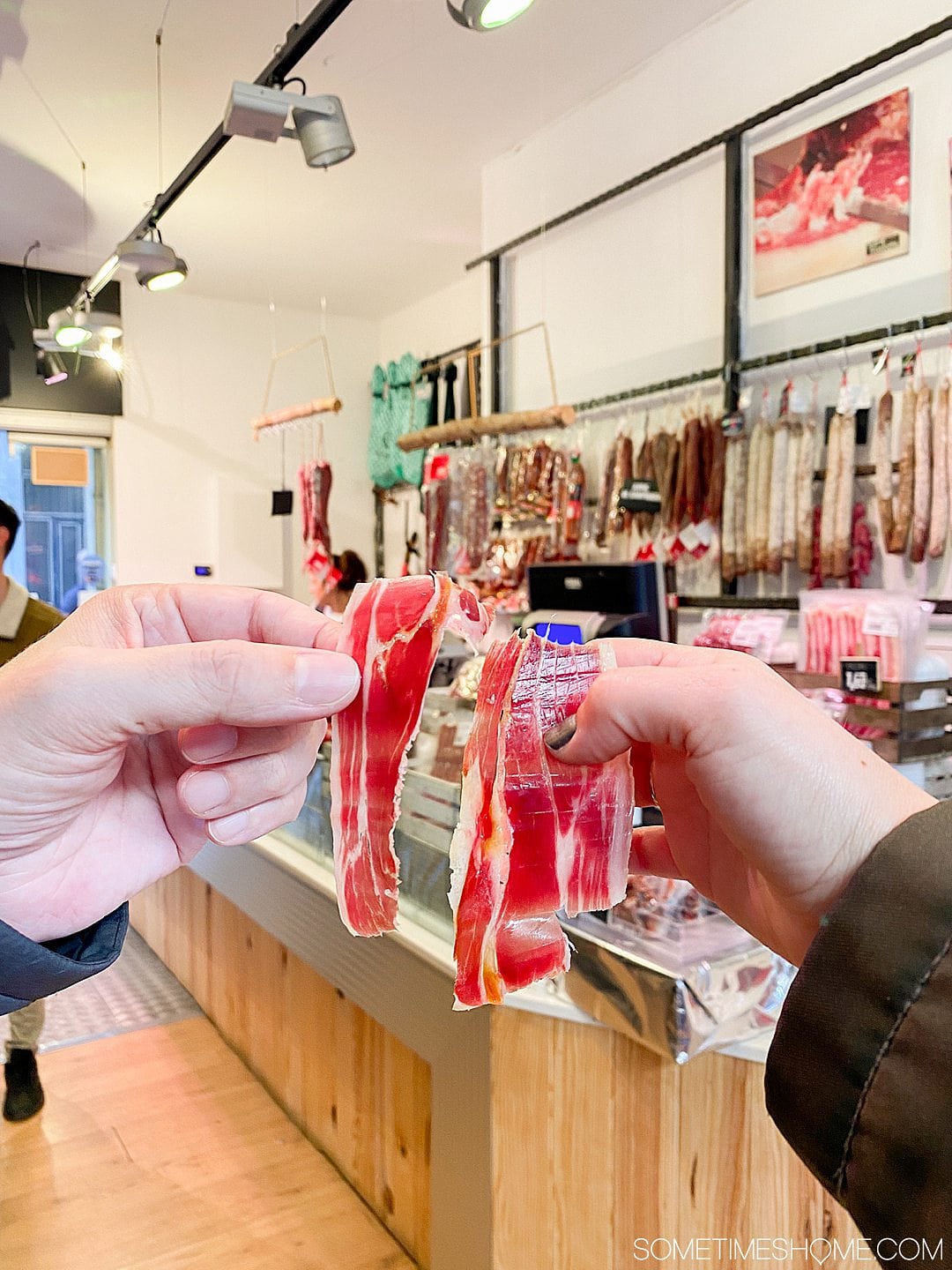
We also made sure to have ham the night before we left Barcelona… Can you tell it's one of our favorite foods in Spain?
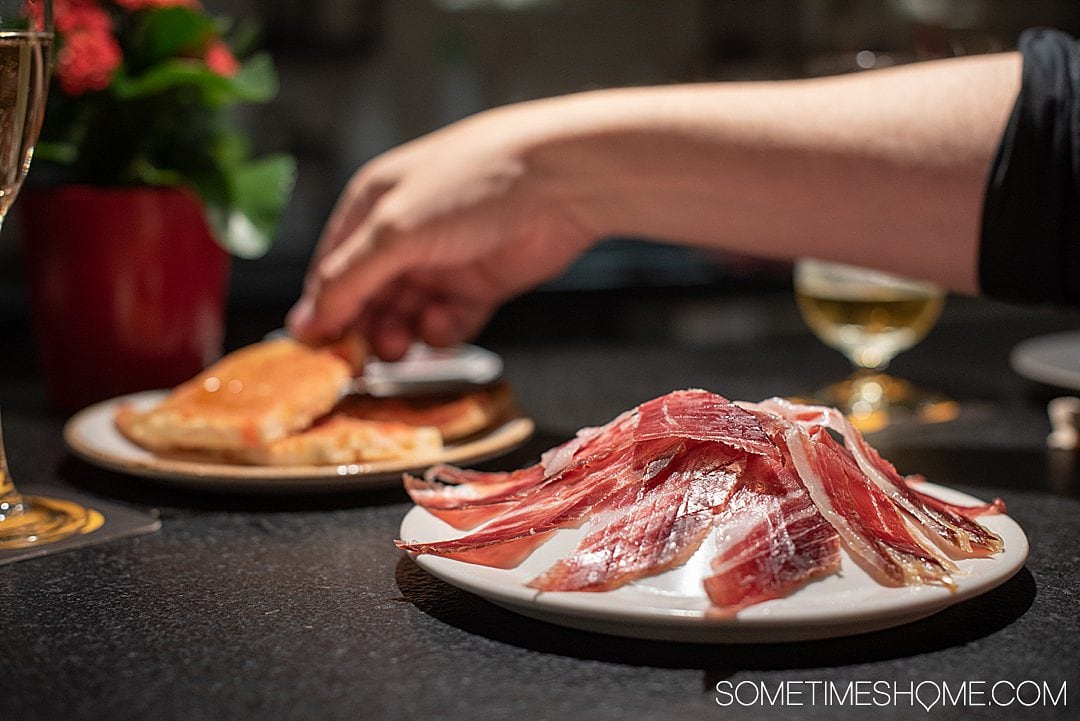
Seafood, Including Razor Clams and Prawns
The seafood we've had in Spain has always been great. Barcelona is on the coast so things are fresh for eating there, from shellfish to fish, mollusks and more.
We enjoyed prawns on our first night in town. We've had them in Spain in the past and they're always served with the shells on. They're easy to get off, and the meat is tender and juicy (if cooked correctly, of course).
Another seafood item I l-o-v-e in coastal parts of Spain is razor clams. They literally look like long knife razors from back in the 19th century. The delicate shells of razor clams can be opened by a pro, and the meat that runs the length of the shell is cooked to perfection.
They're usually available at nice restaurants that serve seafood and mollusks for whatever the market price of the day is.
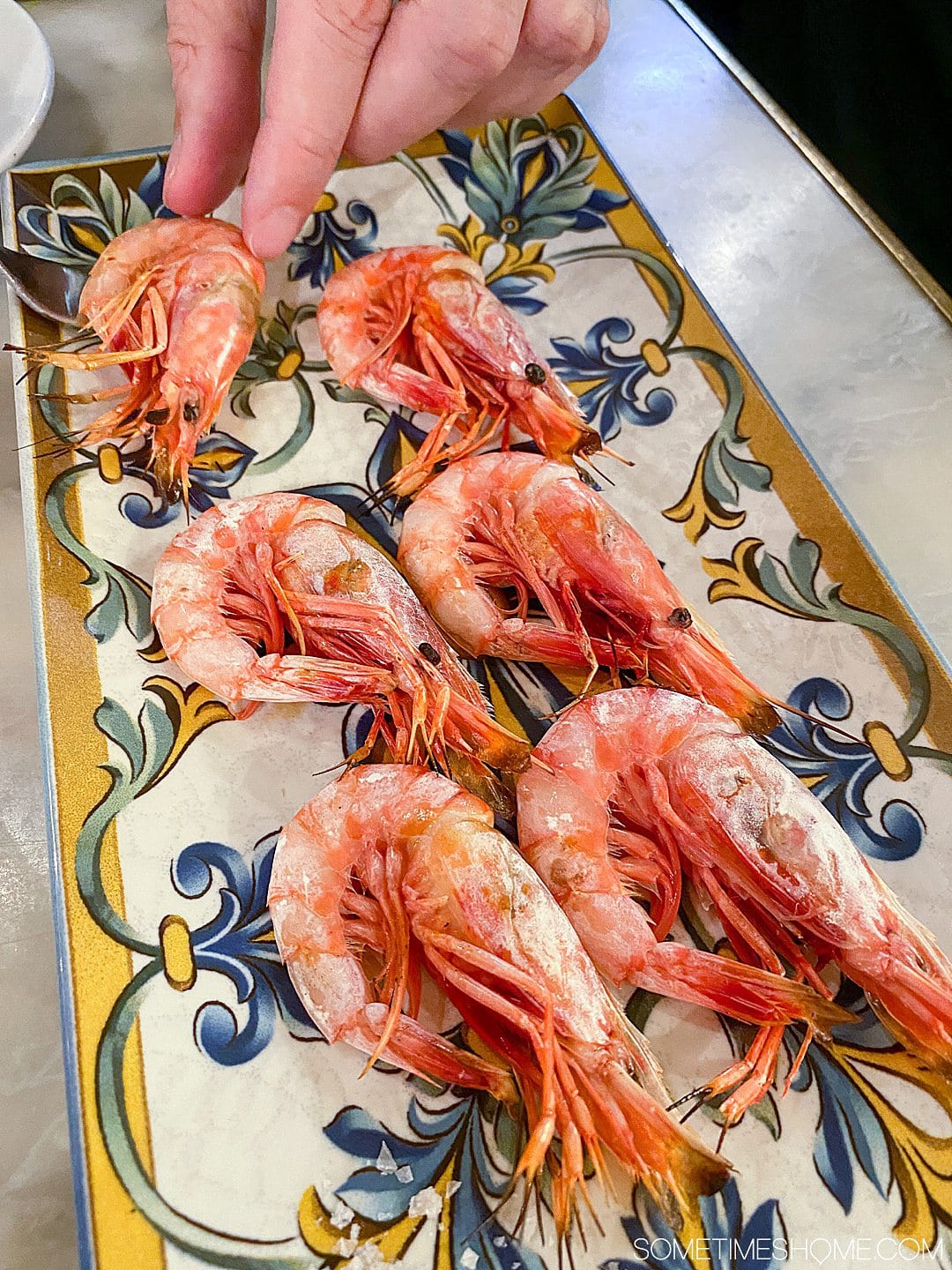
A traditional Catalan dish with seafood is Suquet de Peix, a fish stew. Keep your eyes peeled for this on menus, especially if you go to Catalan restaurants.
Another cool thing we encountered in Barcelona was something like the display below. You'll walk into a restaurant and see the daily fresh offerings from the sea and you can choose what you want to eat. Then the kitchen cooks it and the restaurant serves it to you.
There's a restaurant with eight locations around Barcelona called La Paradeta, whose entire basis of their restaurant is this concept! If you're in the mood for seafood in a no-fuss, inexpensive yet high-quality kind of place, this would be a great option.

Spanish Olives
We were lucky enough to try a variety of olives at a neighborhood market. We learned that there are 43 markets around Barcelona from our Devour Food Tours guide.
He arranged for a sampling of various types of olives for everyone on our Barcelona food tour. Here, we learned that Spanish people prefer pits in olives.
This is because to remove them during the curing process, they would have to be put through a chemical process to soften them to remove the pit. Many people think this affects the pure quality of the olive. Thus, pits are good!
𐂐 🫒 Book a Devour Food Tour to secure your spot on your chosen day in Barcelona! 🦐

One night we had olives that the restaurant served us in a double-sided tray. One side had the olives, and the empty side was for the olive pits. So smart!

Spanish Cheese
We never met a cheese we didn't like, whether enjoying the cuisine of Spain or traditional food in Slovenia. It's so satisfying to have some drinks and cheese.
There are over 150 kinds of cheese in Spain. (Which doesn't contest with the French varieties of cheese but hey, it is worth competing for, right?)
Spanish cheese is typically named after the region the cheese is from and the kind of cheese it is.
Try getting this must-try food at a local market in the neighborhood you're staying in (or from La Boqueria if you fancy it). We also enjoyed a cheese board one or two nights of our trip at El Nacional food hall.

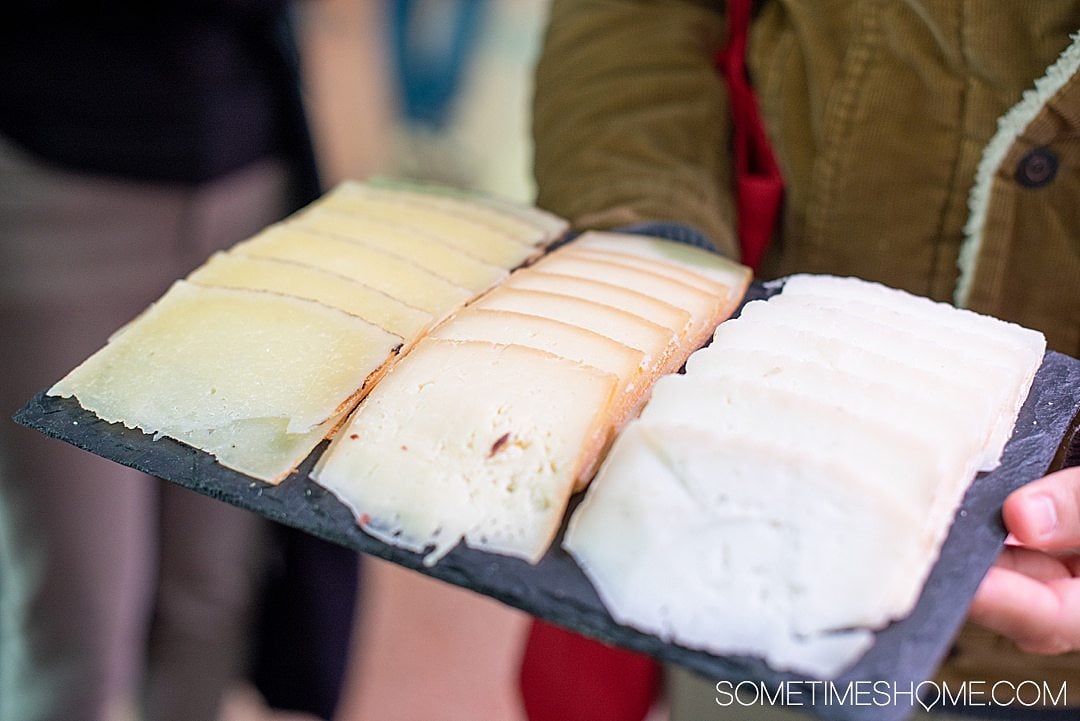
Cava (or Spanish Champagne)
Cava is all over Spain! And we especially loved this must-consume drink in Barcelona. It was the first time we really appreciated it on a trip to Spain.
This bubbly drink is made like champagne, with two fermentations. (Prosecco, from Italy, for example, is not fermented in the bottle the second time like cava and champagne.)

Hot Chocolate, with a Churro and Malandro Cookie
It is pretty well known that Spain is famous for chocolate and churros. (Hot chocolate, to be more specific.) But on our Devour Tour, we learned that a Malandro cookie is the more authentic treat to have with hot chocolate in Barcelona. It's like a Catalan Lady Finger.
I like it more than churros, which feel too fried and heavy to me. A Malandro, on the other hand, is lighter and a great dipping cookie. You must eat this food in Barcelona (or maybe have a couple of them).
Did you know the Spanish had chocolate before anyone else? (Even if you think Mexico did, it's because they were a Spanish colony!) When the church banned chocolate, it was even more appealing…what is forbidden is more desired, eh? That's why there's much more than meets the eye to the hot chocolate and Malandros served in Barcelona.

Tomatoes Two Ways
Tomatoes are glorious! And the people in Barcelona love to use them – often – on bread and as their own solo dish. Here are the two most popular ways they're offered.
Bread with Tomatoes (Pan con Tomate, Pa amb Tomàquet, or Pan Tomaquet)
This is one of my favorite Spanish foods, particularly for breakfast. I first fell in love with Pan con Tomate on a trip to the Andalucia region of Spain, in Seville, Granada and Cordoba. Ever since I make it at home.
A tomato is “juiced” on a grater to make a tomato pulp, of sorts. Then it's spread on top of bread, then topped with Spanish olive oil. If you like, you can add a sprinkle of salt. Sometimes another spice makes it on the tomatoes if the restaurant chooses.
It's so good…but you won't find it anywhere in America on a menu. It's awesome and such a healthy topping for bread.

Sliced Fresh Tomatoes
If a tomato is great and hearty on its own, why dilute it by serving it any other way than to slice it up, add some olive oil, and serve it on a plate?
We went to Bodega Lito (a Michelin-rated restaurant) on our first night in Barcelona and loved consuming small plate after plate of the top Barcelona foods recommendations we asked for. One was the beautiful plate of fresh tomatoes you see below.

We also learned that a specific type of juicy tomato is hung up at markets because their extra-juicy interiors make them extra soft. They're hung to protect them from bruising amongst other veggies!
Tomato juice is often rubbed on top of the bread to soften it, a practice that began during the Industrial Revolution between the 18th and 19th centuries.

Spanish Sandwiches, or Bocadillos
The food in Europe is simply fresher than in the United States. The abundance of so many local markets ensures the ingredients are, in fact, as local as possible, whether that's the bread they use or the meat and vegetables going into a recipe.
Thus, even the sandwiches, or bocadillos, or fresher in Barcelona.
We want to point out two in particular that are typical finds you must eat in Barcelona! One is a sandwich we had the morning of our food tour with a glass of cava. (Because why not? When in Barcelona, do as the Catalonians do!)
They have two breakfasts. The first sweet is at around 8:00am (a lot of people skip that one). The second is savory around two hours later. It can be consumed with or without alcohol.
This is when we had the sandwich – a baguette with Girona pork sausage. It was delicious! It's a winning simple sandwich with great ingredients, making it a superb combination.

The other sandwich is similar: if quality ingredients are used to make something as simple as a ham and cheese sandwich, the creation is instantly elevated.
This is the case with Iberian ham and manchego cheese sandwiches on a fresh baguette. I chose to pair it with fresh-squeezed orange juice for breakfast.
It was simple to grab this quality sandwich at the Enrique Thomas shop at Barcelona's Sants train station before our train to Valencia. (Understandably, we are always nostalgic for Spanish ham when we go to Wynwood, Miami, where there is now an Enrique Thomas restaurant!)

Fried Sardines
We had fried sardines as part of our typical Barcelona food meal at Bodega Lito our first night.
They're a little harder to eat because they have tiny bones you have to pick through in your mouth. But they're really good if done right, and you exercise a little bit of patience with eating them.
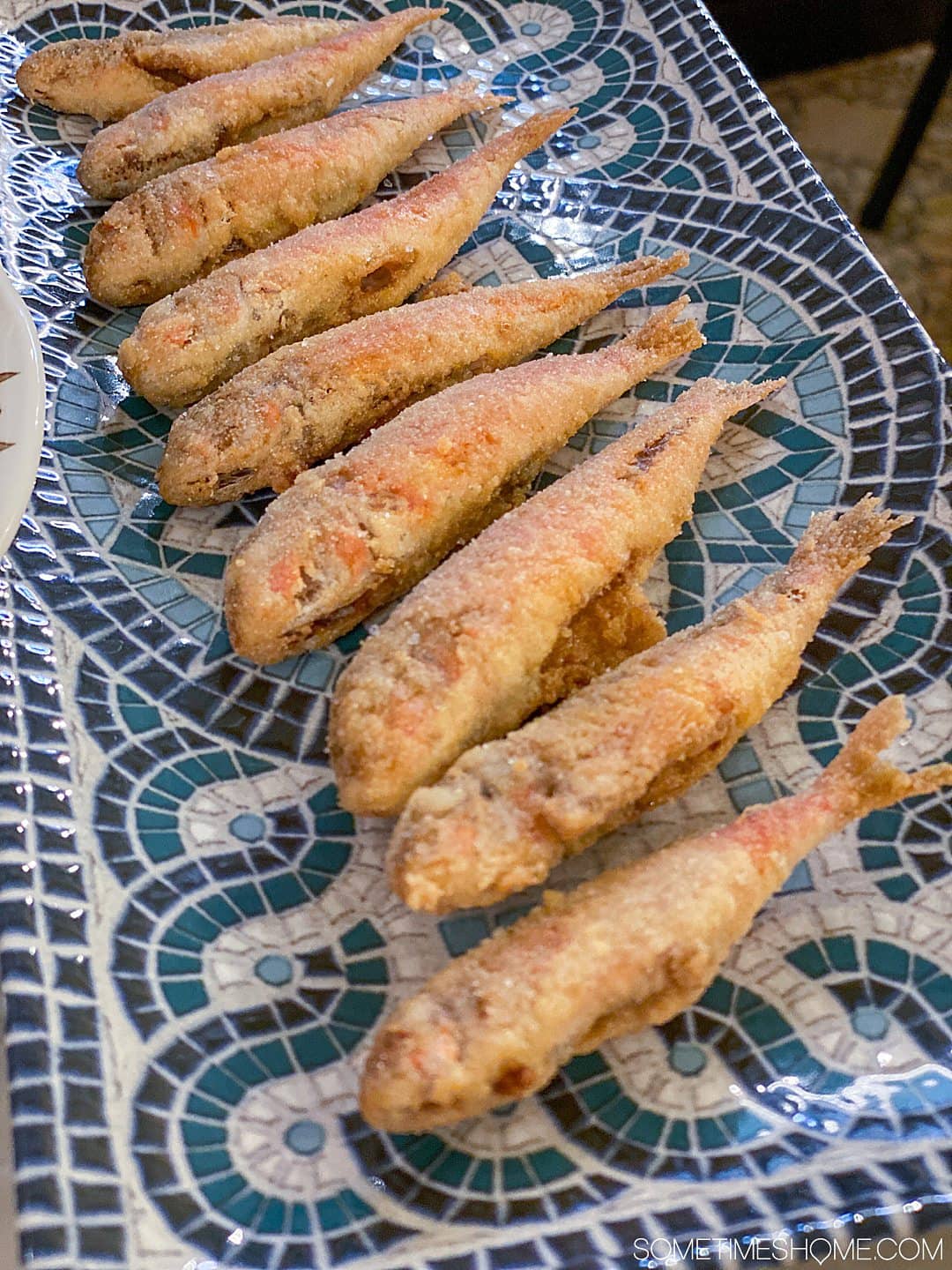
Vinegar and Olive Oil Cured Anchovies
Most American know anchovies as the Italian fish served on Caesar salads. But, typically, they're served purely, in their cured form on a small plate, as a tapa, in Barcelona.
There are two ways you can order them or buy them from a market: as “boquerones,” cured in vinegar (which is when they turn a yellowish white).
Or marinated in olive oil, as you see in the photo below, in a brownish color. These anchovies are from a region of northern Spain called “Santoña” and are very high quality.

Vermouth
The vermouth in Spain is not like the vermouth you have in America, that's added to drinks like dirty martinis. It's different. And I admit I'm not a vermouth expert, but from everything I've learned about vermouth in Spain (including Barcelona) and in America, I certainly know they're very different.
Dan and I were really excited when the final stop on our Barcelona food tour was at a vermouth bar. We were otherwise too shy to go into a bar and order it ourselves. But we were all ears to learn about it with our guide teaching us.
We learned that Sundays, from noon to 2:00pm, are for vermouth in Barcelona with friends! The streets may be empty, but the bars are full. Even if you're getting a beer, it's called “Vermouth time.”
Otherwise, Catalonians have vermouth and a sandwich during the day around 5:00pm when kids get out of school. (Haha – probably not a coincidence.)

Bunyols
We wanted to end this post on a sweet note, mentioning this seasonal pastry.
Bunyols are cream-filled donut-hole-like pastries that are produced around Easter time. They're traditional and delicious so if you're in Barcelona around March through May and see them, buy some! You won't regret it.
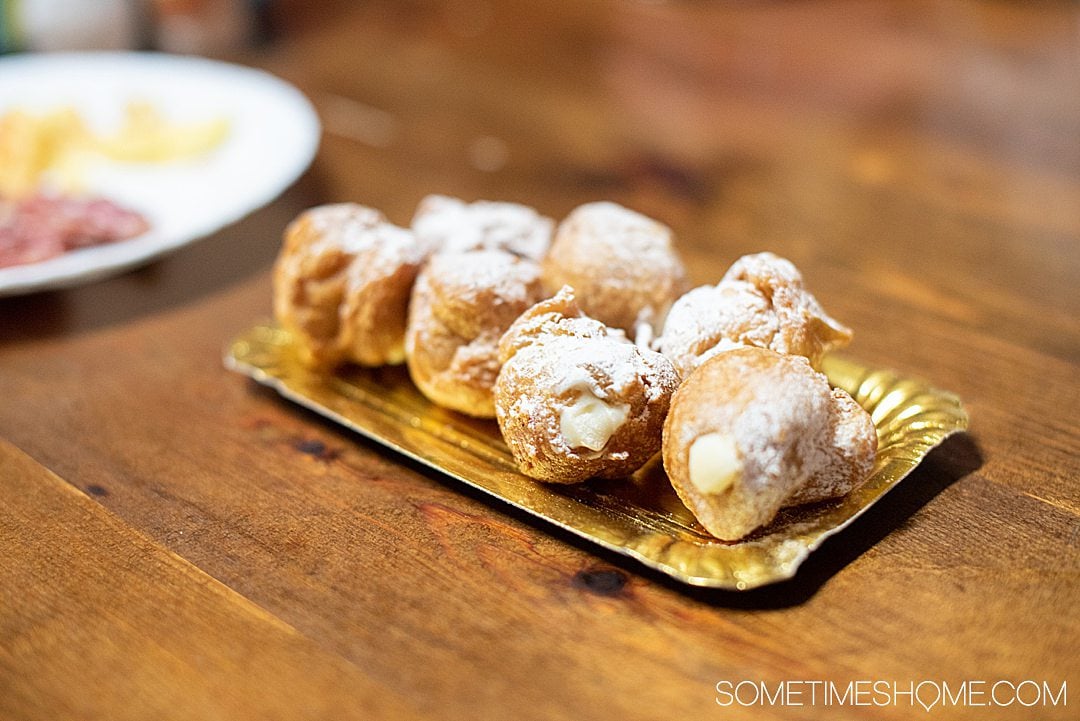
Cooking Classes in Barcelona
Want to try making some of these dishes yourself? A cooking class is a great way to remember not only the flavors and scents of the cuisine but know exactly how to recreate the dishes at home.
Ironically (because it's not a traditional Catalan dish) most of the classes will teach you how to make paella and some other Spanish tapas.
Some cooking classes include a trip to the local market to buy the ingredients together. Of course, they all include wine (lots of wine)…you'll have a great time!
Things to Eat in Barcelona CONCLUSION
Barcelona is a foodie destination, for sure. And whether you're eating breakfast at a cafe in la Gracia neighborhood, or hitting up food markets for quick bites, or at Michelin-starred restaurants, there is plenty to enjoy for all palates and diets across the board.
Heading to Spain? Also check out:
- What to Eat in Valencia that’s Traditional and Delicious
- Madrid to Zaragoza by Train: How to Get There and What to See in a Day
- Eat Your Way Through Seville






I am a tried and true francophile but I will tell you a secret – Barcelona is my FAVORITE city to eat in! When I was working in Switzerland I had a vendor in Barcelona and I would go 2-3 times a year and always extended that to a weekend just so I could shop and eat. When I returned to living in the US I was lucky enough to attend some of the larger tech trade shows in Barcelona as well and I took advantage of each and every meal!
I love this comment, Andi! Haha! We won’t tell – secret’s safe with us! 😉 That’s amazing you were able to weave trips to Barcelona into your work flights and schedules and tech trade shows there!
Ok, so I want to be in Barcelona eating right now!! Beautiful photos, the pinchos looked delicious and agree with you on eating them all the time! We missed trying Fideua, but something to look forward to eating some time in the future!
I’m so glad this brought you back to Barcelona, Bell! We miss all the food too but it leaves us looking forward to the next time we’ll be there! xo
Everything looks so yummy. I think it might be all this food that I miss the most from travelling. I love the Spanish small bites so I can try so many different flavors and, of course, I would want to visit a restaurant that’s 800 years old!
I love your post, as a spaniard I couldn’t agree with you more. All those sites are perfect and these food are really popular in Spain, they are delectable (still I missed tortilla de patatas).
LOVELY BLOG! Kisses!
Thanks so much for your comment, Escámez!